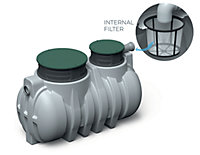See more Water tanks
Underground Water Storage Tank Rainwater Harvesting Landscaping Drainage System 2000L
Sold & shipped by B2C Retail ltd
Available online only and not stocked in B&Q stores
Product details
Product information
Retention and infiltration system:
Principle of operation: rainwater flows down drain pipes and is collectively transported to an underground rainwater filter or goes to a basket filter placed directly in the tank. The rainwater is stored in the tank. Only when it is full, water flows into the infiltration system. Only water that does not fit in the tank goes to the rainwater infiltration system.
Absorbent wells are used for storage and then infiltration of accumulated water in the ground. They are used to drain rainwater from the roof and sewage water from household biological sewage treatment plants.
They are usually bell-shaped without a bottom, with holes in the lower part.
The water is infiltrated through layers of gravel of appropriate granulation. The infiltration well can be used in permeable and poorly permeable soils only if the distance between the bottom of the well and the groundwater level is not less than 1.5 m.
The location criteria for absorbent wells are analogous to the conditions provided for the use of traditional drainage systems. When determining the dimensions of wells with a circular base, the area of the bottom and walls of the excavation is taken into account as the total filtration area.
In accordance with the adopted law, rainwater is considered sewage, and therefore you have to pay tax for its discharge. However, it is worth taking care of the use of rainwater. An absorbent well works best for this purpose. Thanks to it, you can easily drain water to the level of permeable soil. This translates into many benefits, especially when the well is part of household sewage treatment plants.
All tanks come with lids and filtration systems.
110mm connections
- Manufacturer guarantee-3 months
Features and benefits
- An underground rainwater tank is quite a large financial and organizational investment. At the beginning, many questions arise to which we do not know the answers. Sometimes we don't even know what to ask or where to start. What questions to ask specialists?
- The climate in our country is zonal and therefore the first step to choosing an underground rainwater tank is to check the average annual rainfall. Throughout our country, annual average is between 500mm and 1400mm.
- We choose an underground rainwater tank mainly for the surface of our roof, because it is from there that rainwater flows straight to the tank through gutters. The larger the roof area, the larger the rainwater tank should be chosen. Take, for example, a roof with an area of 200m2. Counting that the average rainfall in London is 520 mm, a maximum of 10,400 liters of rainwater will flow into our tank per year. The collected rainwater is used on a regular basis, e.g. for watering. Therefore, the rainwater tank is never full. During a single watering, about 500-600 liters of rainwater are used. In this case, the 5000 rainwater tank should be enough to provide the plants with water during drought.
- Rainwater is suitable for flushing the toilet, cleaning work (washing the patio, car, bicycle and the like - you can even clean garden furniture with it), as well as watering plants. The lack of calcium in rainwater makes it suitable for washing machine. Washing agents dissolve well in soft rainwater, so by cleaning clothes in rainwater, you will reduce the consumption of powder and fabric softener. Remember, however, that water supply to the toilet and washing machine requires an appropriate connection.
- Let a simple calculation be the proof. During the rain, which lasts about 10 minutes, you can collect up to 180 liters of rainwater. That's roughly what you need for 20 toilet flushes, 6 laundry washes or 3 car washes. Thanks to this, it is easy to calculate that the precipitation will allow you to reduce the consumption of tap water by about 80 liters. Over the course of the year, it is more or less 30 m3.
- Not using rainwater is associated with a lot of waste - you pay for tap water that could be used in a different, better way. Using what the earth gives us is in line with the idea of ecological living and less waste. Use natural resources if you have the opportunity!
- Rainwater is not only soft, but also low in chlorine - making it very good for watering all kinds of crops and ornamental plants. A liquid rich in nutrients will be especially useful to those gardeners who grow azaleas and rhododendrons.
- Summary Using rainwater has many advantages - thanks to it you support the development of organic farming and gardening, enrich plants with the right nutrients, and additionally save money. So don't hesitate too long - invest in a rainwater tank and start using it today!
Specifications
| Brand | B2C |
|---|---|
| Pack quantity | 1 |
| Product height | 1490mm |
| Product length | 2200mm |
| Product weight | 700g |
| Product width | 1200mm |
| Material | Polyethylene (PE) |
| Tank capacity | 2000L |
| Product code | 5056697230164 |
